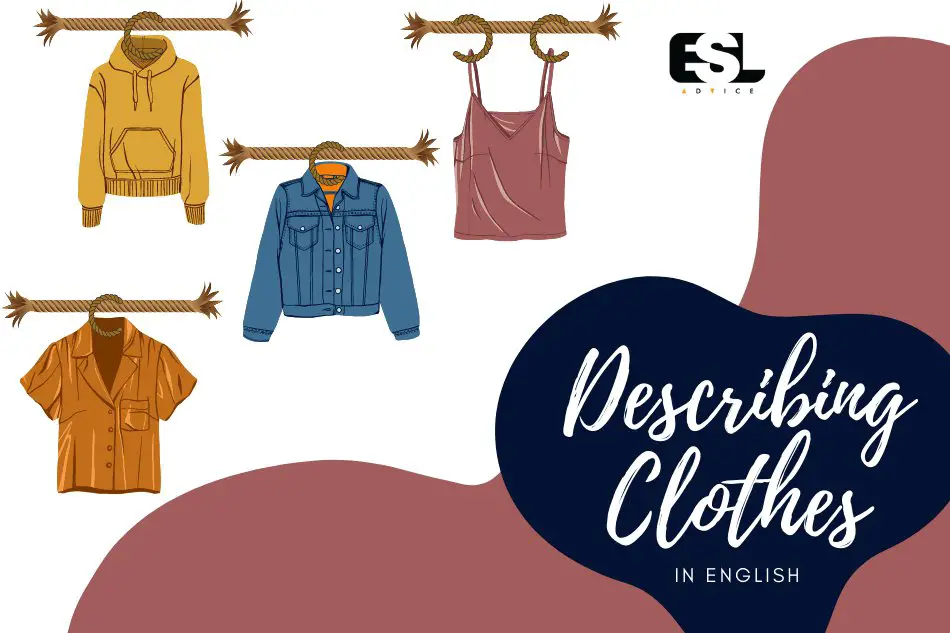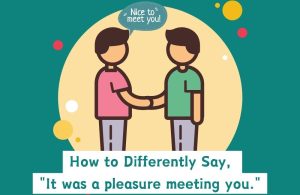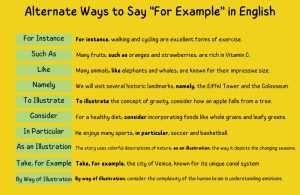This article covers the following areas –
- Common Adjectives to Talk about Clothes
- Talking about COLORS
- Talking about PATTERNS
- Talking about MATERIALS
- Talking about TYPES
- Talking about SIZES
- How to Appreciate Someone’s Clothes
- Final Words
- FAQ: Describing Clothes in English
The clothes someone wears tell us about their cultural identity and life status. When describing someone to someone else, we talk about their outer beauty/appearance and inner qualities/personality. While describing someone’s appearance, the first thing that comes up is the clothes. If you wonder how to describe clothes, this post is for you.
As a general rule, you should talk about the color, pattern, material, and type to describe clothes. There are so many adjectives that you can use to describe clothes. Remember! While describing clothes in English, it’s crucial to follow the order of adjectives.
Weel! To learn adjectives to be able to use in various real-life situations, you may try one of my favorite books, 10,000 Useful Adjectives In English: Types, Degrees and Formation of Adjectives (Amazon Link).
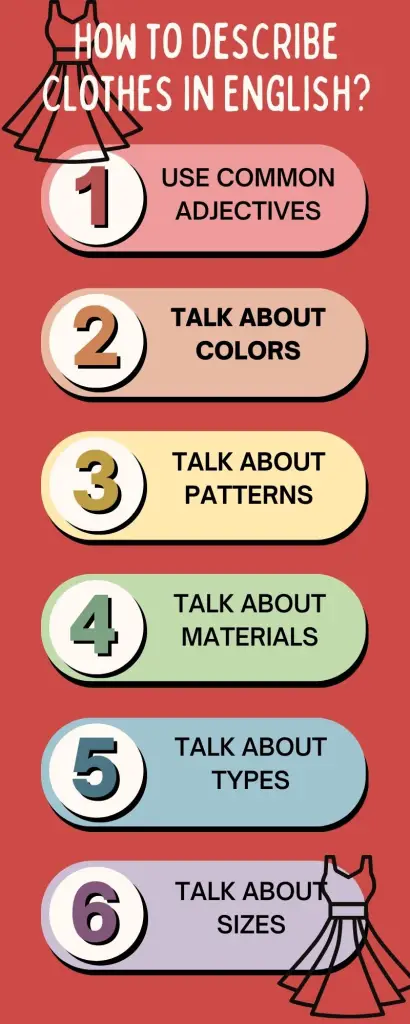
Common Adjectives to Talk about Clothes
| Adjectives | Meaning | Example Sentence |
| Classy | Stylish and sophisticated | The gown you wore yesterday was classy. |
| Stylish | Fashionably elegant and sophisticated | He is old but stylish. |
| Baggy | Clothes that are loose and hanging in folds | I love to wear baggy trousers in summer. |
| Casual | Clothes that are suitable for everyday wear rather than formal occasions | Since it’s a friends’ get-together, let’s wear casual attire. |
| Formal | Clothing suitable for an official or important occasion | Please join the seminar in formal dress. |
| Snazzy | Stylish and attractive | I loved your snazzy silk dress. |
| Colorful | Having much or varied color | She likes colorful dresses. |
| Plain | Ordinary clothes | He prefers plain shirts and pants. |
| Tasteful | Showing an excellent aesthetic taste in clothes | Her tasteful selection of dresses is appreciable. |
| Fashionable | Representing a currently popular style | He is fashionable from an early age. |
| Well-fitted | Fitting closely or comfortably | I always prefer well-fitted t-shirts. |
| Tight-fitting | Fitting or covering in a close manner | Tight-fitting dresses are a bit less comfortable in summer. |
| Trendy | Very fashionable or up to date. | Zara loves to wear trendy clothes. |
| Flattering | Enhancing someone’s appearance. | I don’t find sleeveless dresses flattering |
| Scuffy | Having lost its original fresh or new appearance | They were in scruffy T-shirts and jeans. |
| Sleeveless | Clothes having no sleeves | Do you want to buy this sleeveless blouse? |
Suppose you are a salesperson at a clothing store or an apparel business person. In that case, you must know how to describe clothes to sell your product to the customers. And even while shopping, you may need to describe your desired clothes to the salesperson to get them quickly.
There are so many adjectives that you can use to describe clothes. But remember! English adjectives have their specific order. Let’s know how to describe clothes in terms of color, pattern, material, type, size, fit, brand, etc.
Talking about COLORS
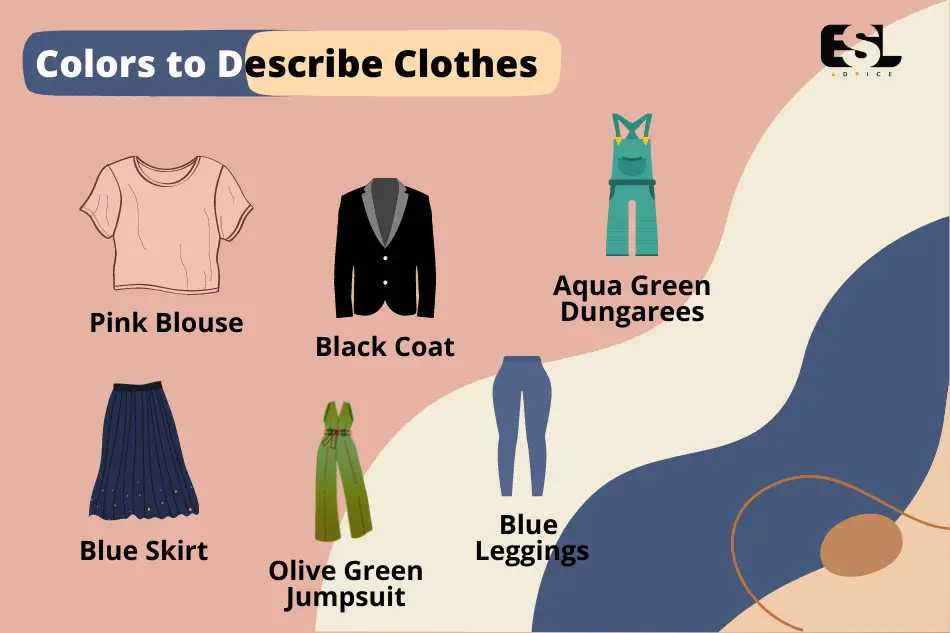
Color is a crucial feature of someone’s dress. In most cases, we describe clothes in terms of their color. The most common colors of clothes are red, black, yellow, brown, blue, green, white, grey, pink, etc.
However, To describe colors in clothing effectively, focus on specificity and context. You may use precise color names like ‘scarlet’ instead of ‘red.’ Also mention patterns and textures that influence color perception, like ‘glossy emerald’ or ‘muted terracotta.’
To improve color vocabulary, let’s see some example sentences that describe clothes well in terms of color.
- He was wearing a blue suit.
- She is wearing a pink t-shirt.
- You look gorgeous in red sarees.
- The man wearing a black shirt is my brother.
- This white Punjabi suits your personality.
- You may choose to wear these maroon pants.
- These blue jeans are very comfortable to wear.
- The blouse was a bright scarlet with a sleek, shiny look.
- His jacket was a deep green with a light herringbone pattern.
- The dress was a soft peach color, light and flowy.
- Her cardigan was a rich emerald green with a cable knit texture.
- The trousers were a muted terracotta, light and airy.
| Colour Vocabulary to Describe Clothes |
| Red, black, yellow, brown, blue, green, white, grey, pink, purple, orange, khaki, navy, sky blue, lilac, aqua, burgundy, beige, blush, champagne, coral, fuchsia, gold, ivory, light blue, peach, rose gold, royal blue, silver, turquoise, etc. |
Sample Conversation: Describing Colors of Clothes
Situation: While enjoying a day out in the city, friends Sam and Riley notice a passerby with a striking outfit, sparking a conversation about its colors.
Riley: Hey Sam, did you see that outfit? What a cool color combo!
Sam: Yeah, really eye-catching! They had on a cherry red leather jacket, which stood out against their navy blue jeans.
Riley: And what about that scarf? It was a bright shade of orange, wasn’t it?
Sam: Absolutely, it was like a vivid tangerine. It added such a vibrant touch, especially paired with their olive green boots.
Riley: True! The way they mixed bold and earthy colors was so unique. It’s not something you see every day.
Sam: Definitely. It’s inspiring to see someone play with colors so confidently. Makes me want to experiment more with my wardrobe, too!
Talking about PATTERNS
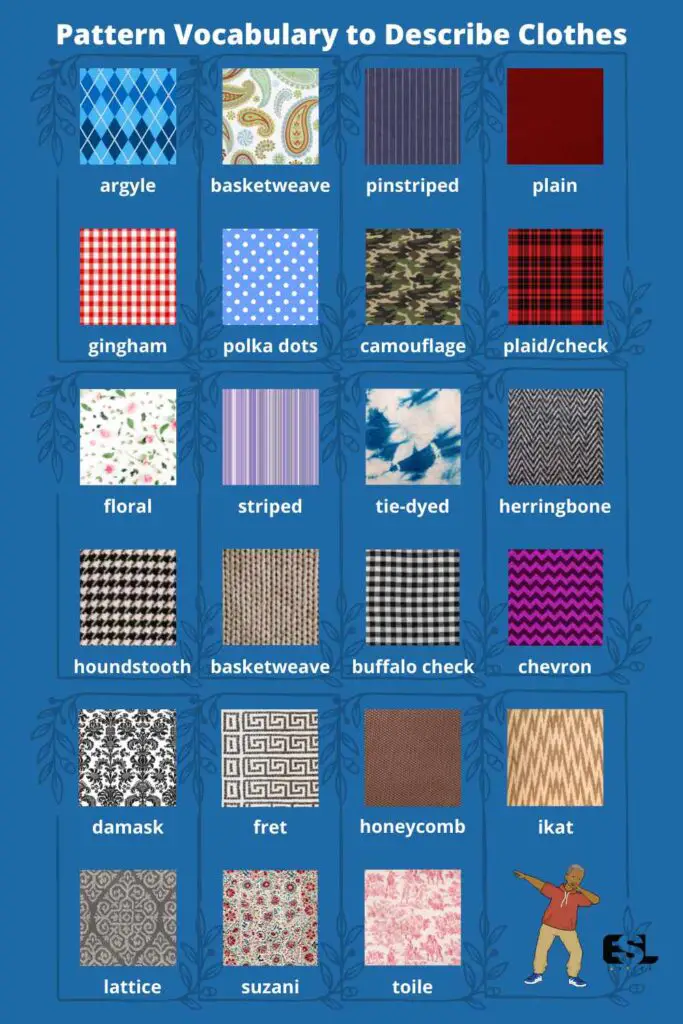
Clothes can be of different patterns. While describing someone’s clothes, mentioning the pattern can help get a clear overall idea about the dress. Typical patterns of dresses are camouflage, plaid/check, floral, striped, tie-dyed, etc.
When describing patterns on clothes, specify the design type, like stripes, polka dots, or paisley. Indicate pattern size (large, small) and color contrast (subtle, bold). Note the arrangement (symmetrical, random) and any unique features, such as gradient effects or texture interplay.
The following examples can help you learn some vocabulary related to clothes patterns.
- I would love to buy this animal print t-shirt.
- He was wearing an argyle-patterned sweatshirt.
- I have a fascination with dresses with camouflage.
- I will wear a check shirt this evening, how about you?
- I like plain dresses as they seem formal.
- The shirt had narrow navy and white stripes, giving it a classic look.
- Her dress had small, evenly spaced polka dots, very playful and retro.
- The scarf had a big, colorful paisley pattern, very eye-catching.
- The skirt had big, bright flowers printed randomly all over.
- His tie changed from light to dark blue, with a smooth gradient effect.
| Pattern Vocabulary to Describe Clothes |
| Argyle, paisley, pinstriped, plain, gingham, polka dot, camouflage, plaid/check, floral, striped, tie-dyed, herringbone, houndstooth, basketweave, buffalo check, chevron, damask, fret, honeycomb, ikat, lattice, suzani, toile |
Sample Conversation: Describing Patterns of Clothes
Situation: During a coffee break at work, Emily compliments her colleague, Ben, on his distinctive shirt, leading to a discussion about its pattern.
Emily: Ben, I have to say, your shirt today is really unique. What pattern is that?
Ben: Thanks, Emily! It’s actually a geometric print. There are these intertwining hexagons in different shades of blue and gray.
Emily: Oh, I see it now. The way the shapes overlap creates a cool 3D effect.
Ben: Yeah, that’s what I liked about it. Plus, the colors are pretty versatile. They go well with my usual black or navy trousers.
Emily: Definitely. And it’s not too loud or busy, just the right amount of flair for the office.
Ben: Exactly! I’m trying to add more patterns to my wardrobe. This was a step out of my usual plain shirts.
Emily: It’s a great choice. It adds so much character to your outfit!
Talking about MATERIALS

Like colors and patterns, there are too many variations in terms of the materials of clothes. Besides cotton and wool, there are other common materials from which dresses are made. They are leather, silk, nylon, fibers, etc.
To discuss materials in clothing, identify the fabric type (cotton, silk, polyester). Note texture (smooth, coarse), weight (light, heavy), and weave (knit, woven). Mention functional qualities like breathability, stretch, or waterproofing relevant to the garment’s purpose and comfort.
The examples below show how to talk about materials while describing clothes.
- My brother loves to wear leather jackets.
- I would love to buy you some silk scarves.
- She is wearing a nylon dress.
- We all will wear the same cotton shirts at the party.
- He loves denim jeans.
- The T-shirt was soft cotton, really comfortable for daily use.
- Her gown was silky smooth, flowing, and elegant.
- The raincoat was light, waterproof polyester, good for rainy days.
- His sweater was thick wool, really warm for winter.
- The yoga pants were stretchy spandex, great for moving around easily.
| Material Vocabulary to Describe Clothes |
| Linen, synthetic, sateen, denim, cashmere, organza, terrycloth, leather, silk, brocade, nylon, fibers, cellulosic, bast, chiffon, dimity, muslin, taffeta, lawn, chintz, dobby, voile |
Sample Conversation: Describing Materials of Clothes
Situation: At a weekend market, Lisa is intrigued by a scarf at a stall and asks the seller, Mark, about its material.
Lisa: This scarf has such a unique texture, Mark. What material is it made from?
Mark: It’s a blend of silk and bamboo fiber. That combination gives it a smooth yet slightly textured feel.
Lisa: Interesting! It feels lightweight but also durable.
Mark: Exactly. The silk provides the softness and sheen, while the bamboo adds strength and breathability.
Lisa: That sounds perfect for different seasons. And the sheen really makes the colors pop.
Mark: Yes, the material holds dyes well, giving it vibrant, long-lasting colors. Plus, it’s eco-friendly!
Lisa: That’s wonderful. I love finding pieces that are not only stylish but also sustainable.
Mark: It’s a popular choice for those reasons. Feel free to try it on and see how it drapes!
Lisa: I think I will. It seems like a versatile piece that could complement many outfits.
Talking about TYPES
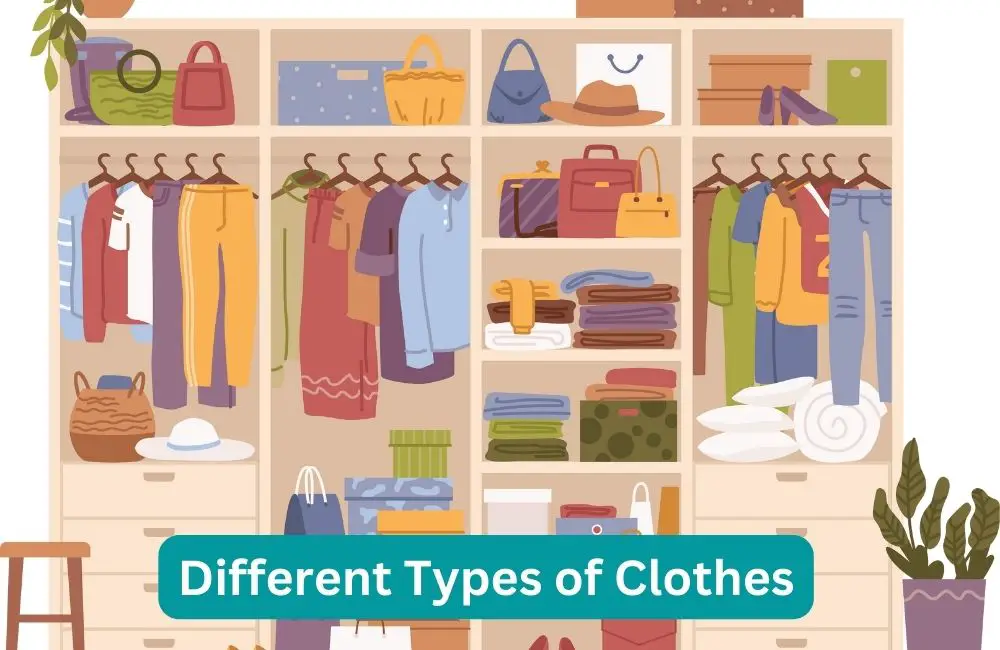
There are different types of clothes we wear. Sometimes it depends on the culture you belong to or your personal preferences. The typical dress types are shirts, pants, t-shirts, jackets, suits, sweaters, etc.
In describing clothing types, categorize them by function (casual, formal, athletic), cut (slim, loose), and style (vintage, modern). Specify garment type (dress, trousers) and distinctive features like neckline, sleeve length, or closures. Contextualize with fashion trends or cultural significance.
Let’s see some examples of sentences to describe clothes types in English.
- Jackets are my favorite attire for winter.
- I will buy my brother a Punjabi this Eid.
- Her scarves are phenomenal.
- Their shirts are of good quality.
- I prefer shirts to T-shirts while traveling.
- The dress was knee-length and casual, with a vintage look.
- His suit was slim and modern, great for formal events.
- The shorts were loose and sporty, perfect for running.
- Her blouse had a wide neck and trendy three-quarter sleeves.
- The jeans were straight-leg and high-waisted, a classic style.
| Types Vocabulary to Describe Clothes |
| T-shirts, sweaters, jackets, coats, jeans, socks, shorts, tracksuits, vests, pajamas, shoes, boots, raincoats, tanktop, swimsuits, skirts, blouses, bras, panties, stockings, suits, shirt, ties, bow-ties, briefs, wool hat, scarf, handkerchief, shawl |
Sample Conversation: Describing Types of Clothes
Situation: While shopping for a party, Anna is helping her friend, Emily, choose an outfit, and they discuss different types of clothing.
Anna: What type of outfit are you thinking of for the party, Emily?
Emily: I’m not sure. Maybe something semi-formal? What do you suggest?
Anna: How about a cocktail dress? They strike a nice balance between formal and casual.
Emily: That’s a good idea. What styles do they come in?
Anna: There are many types. A-line dresses are flattering on most body types, or you could try a sheath dress for a sleek look.
Emily: I like the sound of an A-line dress. Any particular neckline or sleeves I should consider?
Anna: A V-neck can be very elegant. As for sleeves, you could go sleeveless, short sleeves, or even a bell sleeve for a bit of flair.
Emily: I think I’d prefer something with sleeves. Maybe a bell sleeve would be fun!
Anna: Let’s find a few options, and you can try them on. The right type can make a big difference in how you feel and look at the party.
Emily: Agreed. I’m excited to see what we find. Thanks for helping me narrow it down, Anna!
Talking about SIZES
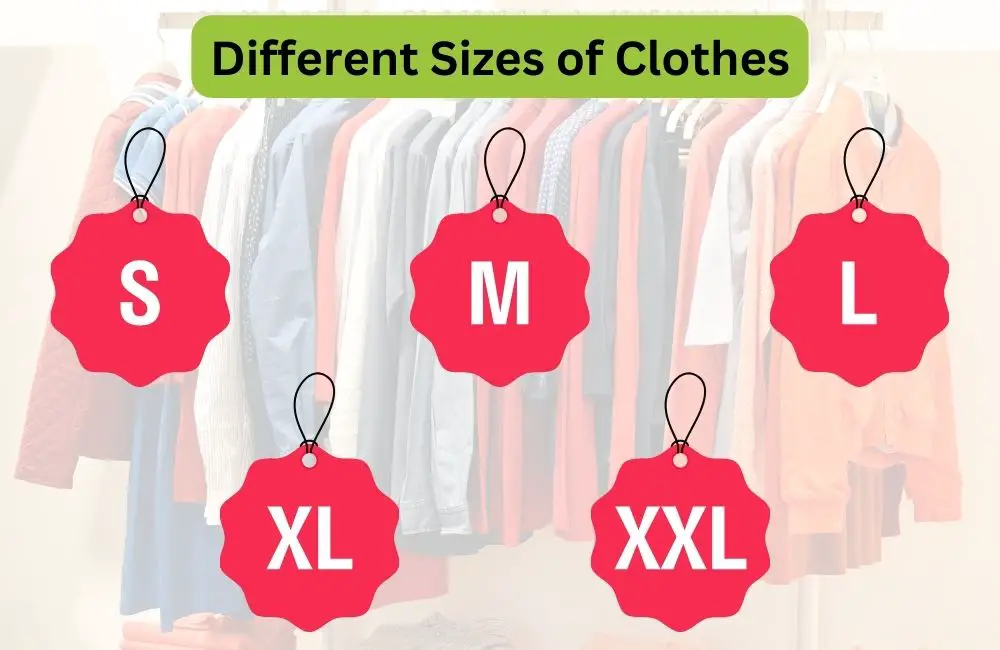
In general, clothes can be of different sizes, such as small (S), medium (M), large (L), etc. However, there are some technical terms used in clothing industries, like extra small (XS), extra-large (XL), and double XL (XXL).
To discuss clothing size, mention standard size categories (small, medium, large), and provide specific measurements (chest, waist, length) if available. Reference fit type (fitted, relaxed, oversized) and any adjustable features like elastic waists or adjustable straps for clarity.
Here are some examples that show the uses of these size vocabulary while describing clothes.
- This shirt might be oversized; you should take a medium one.
- May I have another extra small T-shirt with this pattern?
- The L size (Large) will fit you better.
- The jacket was medium snug, with a 38-inch chest.
- Her dress was small, with a comfy elastic waist.
- The jeans were large, relaxed, with a 34-inch waist.
- His T-shirt was extra-large, really roomy, with adjustable sleeves.
- The skirt was medium, 26 inches long, and fitted well.
Sample Conversation: Describing Sizes of Clothes
Situation: During a shopping trip, Liam is helping his brother, Ben, find a suit for a job interview, focusing on finding the right size.
Liam: So, Ben, what size suit are you looking for?
Ben: I’m not entirely sure. I think I’m around a 40 in the jacket, but I’m not certain about the pants.
Liam: Well, suits typically come with standard pant sizes matched to the jacket. But we can always get them tailored for a perfect fit.
Ben: I’ve heard of ‘slim fit’ and ‘regular fit.’ What’s the difference?
Liam: Slim fit is more tapered and closer to the body, while regular fit offers more room and comfort. It depends on your preference and body type.
Ben: I might prefer a regular fit, then. What about the length of the trousers and sleeves?
Liam: The trousers should rest lightly on your shoes, creating a small break. The sleeves should end just above your wrist bone, allowing a quarter-inch of the shirt cuff to show.
Ben: Got it. And should the jacket be snug or loose?
Liam: It should fit snugly but not be too tight. You should be able to button it without pulling and have enough room to move your arms freely.
Ben: Great advice, Liam. Let’s find some options, and I’ll try them on.
Liam: Absolutely. Remember, comfort is key, especially when you’re in an interview. You want to feel confident and at ease.
Are you looking for a book or a guide to help you learn and improve your English? You may try English Made Easy Volume One: A New ESL Approach: Learning English Through Pictures (Amazon Link). This book creatively uses pictures and text in tandem to revolutionize English language learning, making it easier to understand and more effective overall.
How to Appreciate Someone’s Clothes
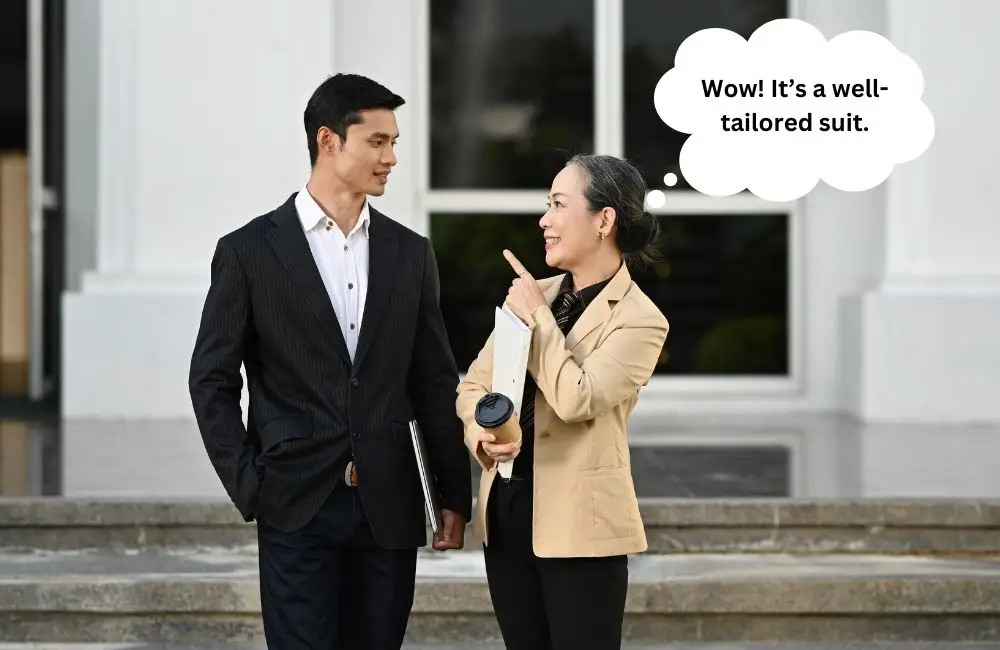
Appreciating someone’s clothes can help you build a good rapport while meeting them. Your compliment can also boost their confidence and make them feel good.
To appreciate someone’s clothes, commend the specific aspects like color harmony, fabric quality, or unique design. Acknowledge how the outfit complements the wearer’s style or physique. Express genuine admiration without overemphasis, and maintain a respectful and courteous tone.
Let’s see some examples using some adjectives to appreciate someone’s clothes.
- This shirt fits you very well.
- Nice dress!
- Wow! It’s a well-tailored suit.
- The shoes match well with your coat.
- You look fabulous in this attire.
- The color suits you well.
- You look gorgeous in sarees.
- Nice jeans! The blue goes well with the T-shirt.
- You look taller in these pants.
- I like how your dress’s colors blend; they suit you well.
- Your suit looks great; the fabric quality stands out.
- The design of your shirt is unique and highlights your style.
- That skirt fits you perfectly and complements your figure.
- Your outfit is well-coordinated and shows great taste.
Sample Conversation: Appreciating Someone’s Clothes
Situation: At a casual office party, Emily compliments her colleague, Sarah, on her unique and stylish outfit.
Emily: Hey Sarah, I just wanted to say your outfit today is absolutely stunning!
Sarah: Oh, thank you so much, Emily! That’s so kind of you.
Emily: I love how you’ve coordinated the colors. The deep blue of your dress really complements your style.
Sarah: I appreciate that. I was a bit hesitant about the color, but I’m glad it worked out well.
Emily: And the design of the dress is so unique – the asymmetric cut gives it a really modern feel. Where did you find it?
Sarah: I actually stumbled upon it in a small boutique downtown. They have some really unique pieces.
Emily: It suits you perfectly. And the way you’ve accessorized with those silver earrings and the minimalist necklace is just the right touch.
Sarah: Thanks! I always believe less is more when it comes to accessories.
Emily: Well, you’ve nailed it. It’s professional yet fashionable. You must give me the name of that boutique!
Sarah: Absolutely, I’ll send you the details. And thank you again for the compliment; it really means a lot!
Final Words
Describing clothes in English is more than just a functional skill; it’s an art that enriches communication and personal expression. Whether you’re engaged in fashion blogging, online shopping, or sharing style insights, knowing the right adjectives for colors, patterns, materials, types, and sizes is crucial.
This knowledge allows for precise and vivid descriptions, enhances your language skills, and helps you connect with others over shared interests in fashion and style. Describing clothes can reveal much about our personality, cultural background, and even mood.
As you navigate the world of fashion and style, remember the power of words. The right description can transform a simple garment into an emblem of elegance and personal expression. So, whether you’re complimenting someone’s attire or choosing your own outfit, thoughtful and accurate descriptions can significantly enrich the experience.
FAQ: Describing Clothes in English
1. Why is it beneficial to describe clothes accurately in English?
Accurate descriptions are vital in various scenarios like online shopping, where buyers rely on written details, in fashion blogging for giving vivid reviews, or in lost and found situations to identify clothing. For personal stylists, it’s essential to articulate clothing details to clients. Accurate language helps avoid misunderstandings, ensuring the right garment is discussed or selected.
2. What are essential terms to know when describing clothes?
Knowing key terms enhances clarity and precision. Garment types (like ‘blazer’, ‘maxi dress’) specify the clothing item. Fabric materials (such as ‘suede’, ‘linen’) describe what the item is made from, affecting its look and feel. Patterns (like ‘chevron’, ‘paisley’) and styles (such as ‘bohemian’, ‘minimalist’) convey the aesthetic appeal. These terms help in painting a clearer picture of the garment in question.
3. How can color descriptions enhance clothing descriptions?
Precise color descriptions bring life to the clothing image. Instead of generic colors, using terms like ‘turquoise’ or ‘saffron yellow’ provides a specific shade, enhancing the mental image. It’s particularly useful in online settings with inaccessible visuals or detailed fashion discussions. This specificity can be crucial for outfit color matching or conveying a particular style or mood.
4. Can body language help when describing clothes?
Body language acts as a visual aid in clothing descriptions. Gestures like pointing to a sleeve’s length or the neckline’s cut make the description more dynamic and easier to understand. This is especially helpful in person-to-person interactions, like in retail settings or when giving fashion advice, making the communication more engaging and clear.
5. How can I describe the fit of clothing?
Describing fit involves understanding how the garment sits on the body. Terms like ‘snug’ imply a close fit, while ‘oversized’ suggests a looser style. ‘A-line’ indicates the garment flares out from the shoulders or waist. These descriptors help people understand whether the clothing will be comfortable, suitable for their body type, and align with their style preferences.
6. What should I consider when describing clothes for different occasions?
The context of the occasion plays a crucial role. Describing attire as elegant or sophisticated with materials like silk or velvet is appropriate for formal events. For casual settings, highlighting comfort and ease, like ‘stretchable fabric’ or ‘lightweight,’ is useful. Cultural sensitivity is also important, considering what is traditionally acceptable or preferred in different cultural contexts.
7. How can I handle situations where I don’t know specific fashion terms?
In such situations, it’s effective to rely on basic descriptors: shape, color, texture, and function. Compare unfamiliar items with common ones (‘similar to a cardigan but lighter’), use relatable language, and be open to asking for help or researching to expand your fashion vocabulary. This approach ensures communication remains clear and accurate.
8. Are there cultural nuances in describing clothes?
Understanding cultural nuances is crucial in accurately describing and respecting clothing choices. Different cultures have unique clothing styles, names, and traditional wear. For instance, a ‘kimono’ in Japanese culture has specific connotations and design elements. Recognizing these nuances avoids miscommunication and shows respect for cultural diversity.
9. How can I teach children to describe clothes?
Children learn best through engaging, hands-on experiences. Encouraging them to describe what they’re wearing or seeing in a storybook helps build their descriptive skills. Ask them about colors, shapes, and how the clothes might feel. Shopping trips can be educational, discussing the different types of clothes, their textures, and their purposes. This interactive approach makes learning about clothes fun and practical.
10. Is it important to describe the texture or material of clothing?
Absolutely. The texture or material affects multiple aspects: comfort (like ‘breathable cotton’), care instructions (‘delicate silk’), and suitability for occasions or seasons (‘warm woolen sweater’). Describing these elements gives a complete understanding of the garment, aiding in making informed decisions for wearing or purchasing. It’s also key in setting expectations regarding the garment’s feel and look.
If you have further questions or suggestions about anything specific related to this topic or anything else related to learning English as a second language, feel free to ask me in the comment box. You may also help the ESLA community by putting your valuable suggestions here to help every member improve their English language skills.

